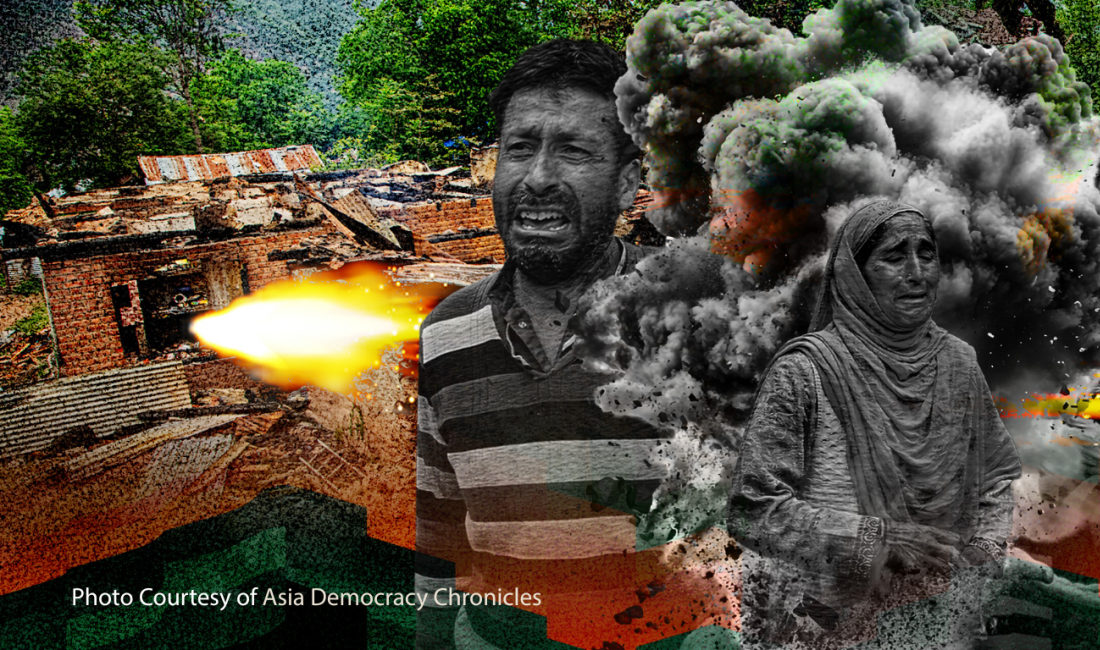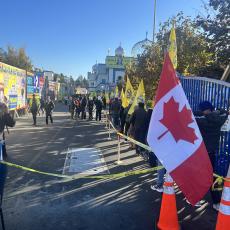Along the India-Pakistan Line of Control, Villages Are Disrupted and Shattered by Conflict
This story was first published and produced by Asia Democracy Chronicles.
As darkness settled over the Razarwani hamlet in Uri, in India-administered Kashmir, 20-year-old Sanam Bashir sat with her books in the quiet of her family’s modest house.
But an ear-splitting blast broke the silence just a few hours later, at nine in the evening of May 8. Mortar shells rained down, some crashing just meters from the door of Sanam’s home. One shell struck a neighbor’s house; another lit a fire in the nearby woods. Sanam and the rest of her family would try to flee by car, but not all of them would survive.
Razarwani lies close to the Line of Control (LoC), the heavily militarized de facto border that cuts through ridges and rivers in Kashmir and divides it between India and Pakistan. Kashmir was the epicenter of rapidly escalating tensions that pushed the two nuclear-armed nations to the brink of war in May.
India and Pakistan have since struck a fragile truce, but many fear it may not hold. Experts even warn that the recent escalation has given rise to a precarious situation that can push the entire region into an unending cycle of violence as the threshold for conflict has lowered. And so while Kashmiris struggle to bring back a sense of normalcy, uneasiness and tension hang in the air.
India and Pakistan have long been on divergent paths, having fought three wars over the Muslim-majority region of Kashmir, each claiming it in full but controlling only parts. In 1989, an armed insurgency broke out in Indian-administered Kashmir, as thousands of men crossed into Pakistan-administered territory for arms training and logistical support to fight against the Indian state.
Despite India’s decades-long crackdown, militancy in Kashmir has persisted for over 30 years. But tensions between India and Pakistan escalated into a military clash after terrorists last April 22 killed 25 Hindu tourists and a Kashmiri Muslim horse rider in Indian-administered Kashmir.
New Delhi blamed Islamabad for the attack and vowed a “harshest response,” despite the latter saying it had nothing to do with it. Two days later, Kashmir police identified three suspects—a local Kashmiri and two Pakistanis—and offered a bounty for each; all three still remain at large.
By May 7, India launched strikes on alleged terror infrastructure in Pakistan and Pakistan-administered Kashmir, pushing both nations to the brink of full-scale war. In their most expansive military clash in decades, both sides deployed drones and missiles against key military bases and airfields.
Both later claimed to have dealt heavy blows to the other’s strategic targets, but reports suggest the actual damage was limited on either.
That is, save for the villages along the LoC that bore the brunt of the relentless gunfire and cross-border shelling for at least three days. By the time U.S. President Donald Trump announced a Washington-brokered ceasefire on May 10, at least 21 people had been killed in Indian-administered Jammu and Kashmir, including five children and over 50 injured.
Reports from Pakistan put civilian deaths there at 40. It was the worst outbreak of violence between the South Asian nuclear powers in decades. As always, civilians paid – and are paying – the highest price.
A family’s tragedy
In the border town of Northern Kashmir’s Uri and its surrounding villages, families accustomed to decades of tension said that this round of fire was the most intense and indiscriminate in memory.
Per local estimates, the unprecedented force of the assault left at least 400 structures, including homes and shops, destroyed and turned several villages into hollowed-out ruins.
“It felt like death was all around us,” Sanam said of the night of May 8. “Most of the village had already fled, and my mother decided we had to leave too.”
Her mother, Nargis Begum, 47, had packed the family into three cars. Sanam was with her mother, two uncles, aunt Hafeeza Begum, and two young cousins. Just 10 minutes into their escape came a piercing shriek from Hafeeza. Sanam turned and saw blood pouring from her aunt’s head; shrapnel had torn through the car’s roof.
“Before I could reach my aunt, I saw my mother,” Sanam said. “Her head slumped unnaturally. “As I touched her face and neck to lift her up, my hands and clothes were soaked in blood.”
A splinter had slashed Nargis’s face and throat. “By the time we reached hospital, she was already dead,” said Sanam, before breaking into sobs. “Just like in my childhood, she silently bore all the pain to raise me. Even in her death, she didn’t let me feel the pain she suffered.”
Nargis had worked at a local school, preparing meals for less than $15 a month. Her husband, daily-wage laborer Basheer Ahmed Khan, had health problems that kept him from working regularly. They and their six children lived in a cramped rental home, but they had been waiting to move into a house of their own, which was in the process of being built.
Now, the family sans Nargis shelters in a relative’s house, unable to return to what they call “a home that now feels like a grave.”
“We had almost finished building our home,” said Khan. “It was (Nargis’s) dream. She had poured her heart into every corner of that house. She should have been the first one to step into that house. How can I walk into it now, knowing she’ll never be there? Every place feels full of her and yet painfully empty.”
“One of our daughters was to be married this year,” he said. “We dreamed of seeing our girls as brides together. That dream died with her. In a war we never chose, my soulmate, my guide was taken from me and my children lost the only shade they ever knew.”
Picking up pieces
Other residents of border villages, meanwhile, have been returning — not to homes, but to the ruins of their lives.
Among them is Ritan Thakur from Lagama village, 12 km from Uri, who Asia Democracy Chronicles (ADC) found sifting through the charred remains of his two shops.
“These shops were our only lifeline,” he said. “What’s left behind isn’t just ash but it’s the ruins of our future.”
Thakur’s family had run the shops for years, selling daily necessities just outside their home. Thakur’s father died years ago, and he had been helping his mother with the business.
“We had just closed up when shells started raining down,” Thakur, 22, said. A projectile hit the shops, set them ablaze, and reduced them to rubble. It also shattered windows of their two-story house and cracked its walls.
“The impact [of the projectiles] was so strong, we thought we wouldn’t survive,” he said, as his mother stared silently at the ruins. “We lay flat on the floor, remembered my father, and just prayed.”
“Just a week ago, I had restocked goods worth $6,000,” Thakur said. “It’s all gone now. What was our fault?”
Past skirmishes mostly driven by small-arms firing between India and Pakistan, “rarely affected” their village, Thakur recalled. “But this time it was different,” he said. “It felt like they were aiming for civilians. The damage wasn’t random; it felt deliberate. The devastation was unreal.”
Six other Lagama shops were reduced to ashes. Said Thakur: “For India and Pakistan, things may have returned to normal. But for us, our livelihoods are gone. Every moment, we live in fear that this fragile peace could break at any time.”
Nearby Gingal village is similarly scarred. There, Mehmood Ali’s family had fled in terror on the night of May 9, as shells exploded through the mountains. Though the chicken coop and trees on their property survived, their home did not.
“I have many health problems,” said Ali, whose house was near three Indian military camps. “But I would often skip doctor visits just to save money and rebuild this house.”
Having spent 20 years saving for his home, the 45-year-old laborer is now haunted by one question: “How will I rebuild again?”
Ali and his family are currently staying at a mosque, along with many others displaced by Pakistan’s shelling in Gingal and other border villages.
“My mother is still in shock,” Ali said. “She cries constantly and asks why this happened to us. I feel traumatized too. I can’t even bear to step onto the lawn.”
Shrapnel also tore through his cousin’s home. Ali said, “His daughter’s wedding was planned for this year but the splinters ruined most of her clothes and even the utensils. What did she do to deserve this? I can’t understand why this war was forced on us.”
The regional government has taken responsibility for assessing damage and offering compensation. Authorities visited Ali’s home just days ago, but he remarked, “[Officials] come, collect our details, and leave. No one has provided us a tent, let alone help rebuild our house or build bunkers for our safety.”
Losers all
Yet there is palpable wariness in Kashmir. In his first speech after India’s strike in Pakistan, Indian Prime Minister Narendra Modi had said that Operation Sindoor—the strike against Pakistan’s terror infrastructure – was only “paused,” and vowed that India would “retaliate on its own terms.”
“[Operation Sindoor] was the culmination of kinetic engagement that has been recorded in the past few years, since Modi came to power,” conflict expert Angshuman Choudhary told ADC. “In terms of strategic dynamics, one new term of engagement that India has set is that it is now in a constant state of combat. Unlike in the past, the escalation ladder this time seems to be open-ended.
That essentially means that India could initiate another round of hostilities the moment there is another militant attack in Kashmir or elsewhere before triangulating the evidence behind the attack.”
Unlike previous conflicts, India struck not only Pakistan-administered Kashmir but also Pakistan’s economic heart: Punjab province, home to most of the country’s army recruits. A former Indian army commander requesting anonymity described the strike as “strategic signaling that India will not restrict itself to only PoK [Pakistan occupied Kashmir] but also hit Pakistan’s heartland.”
“Which is of course worrying,” said the ex-military official, “because it constrains the space for any diplomatic rapprochement.”
A South Asia expert who also declined to be named said that far from deterring Pakistan, India’s strike has instead provoked it, and especially its army chief, Asim Muneer.
“Muneer is a mirror image of Modi’s leadership in India and has built an entire aura of opposing India and upping the ante in ways his predecessors did not,” the expert observed. “If he feels his popularity is tanking, he will retaliate, not in a conventional way, but in a sub-conventional space with greater aggression.”
Experts agree, though, that the recent escalation had no clear victor. Bashir Ahmed Khan, Sanam’s father and Nargis’s widower, also said that he doesn’t know “who won or lost.”
“But the innocent and poor,” he said, “they definitely lost.”



